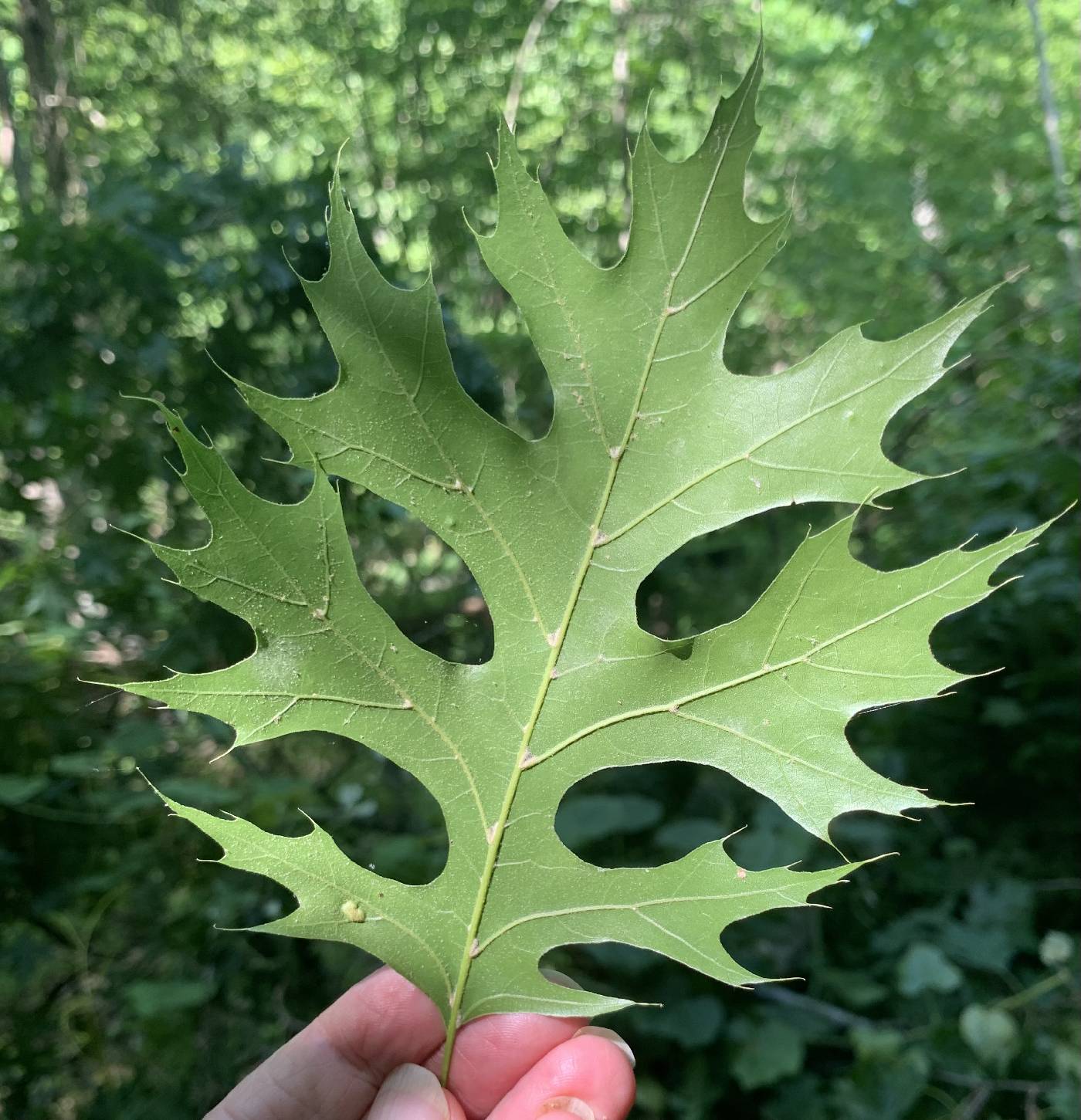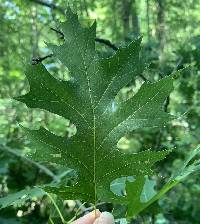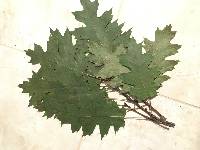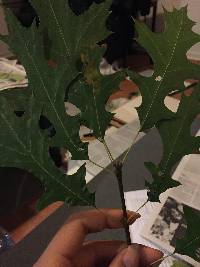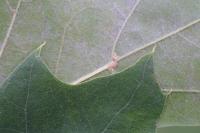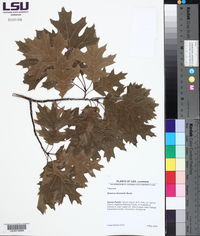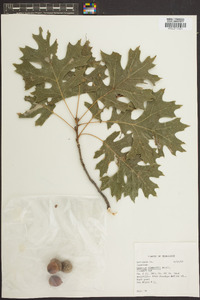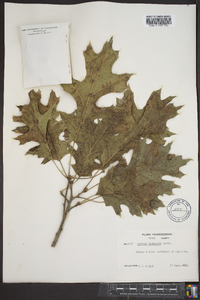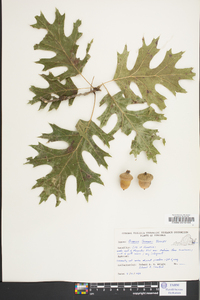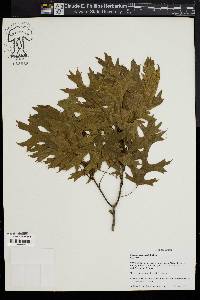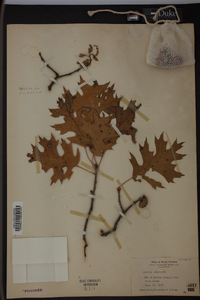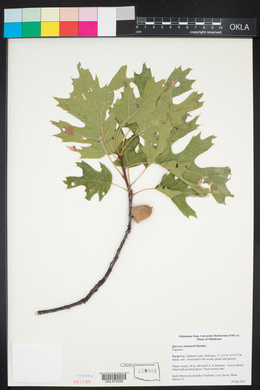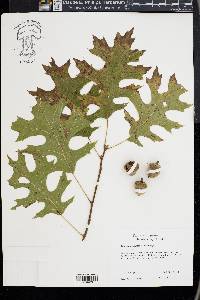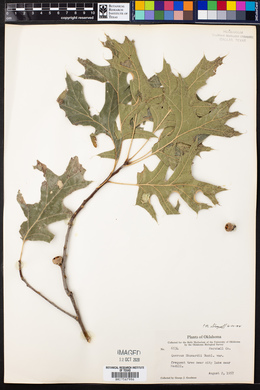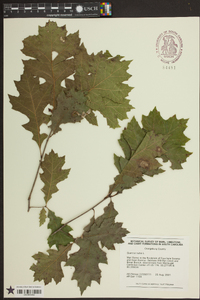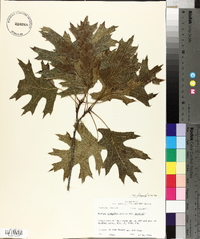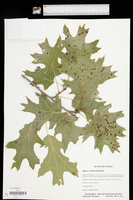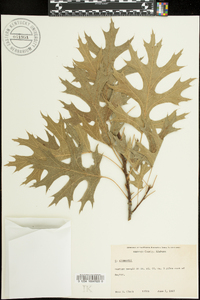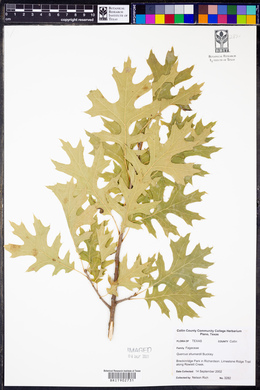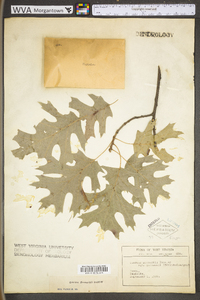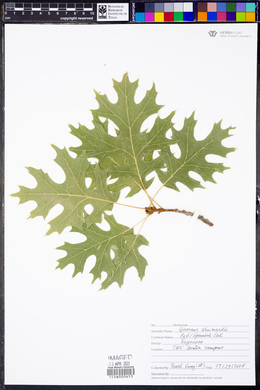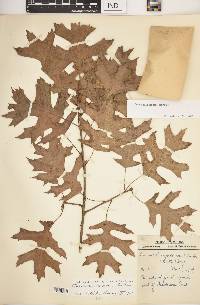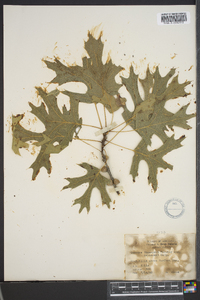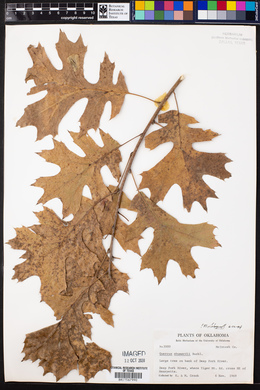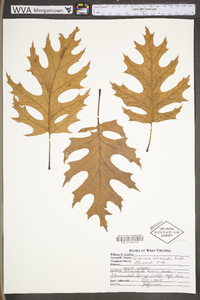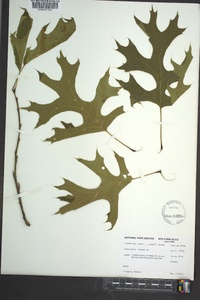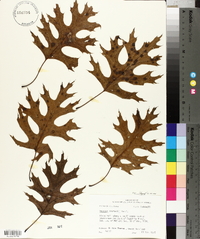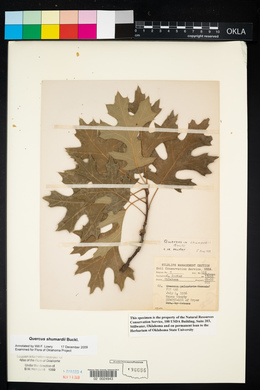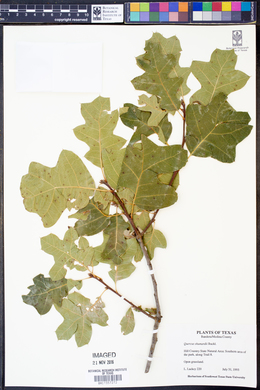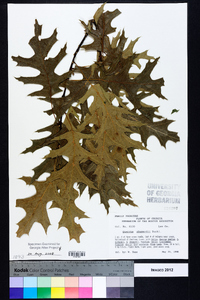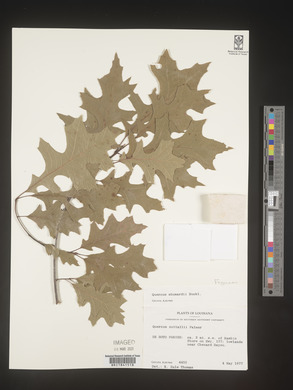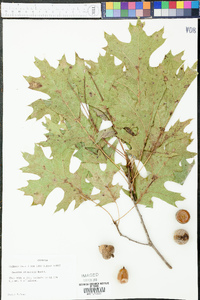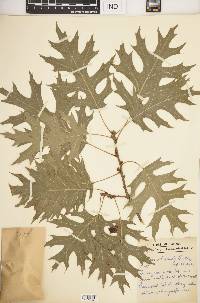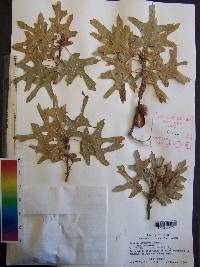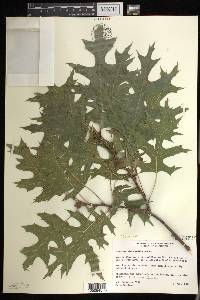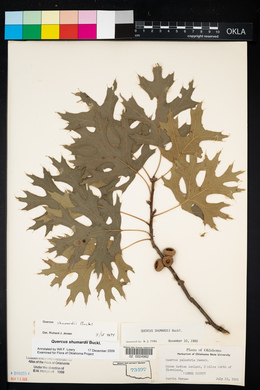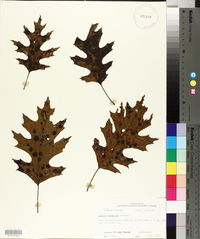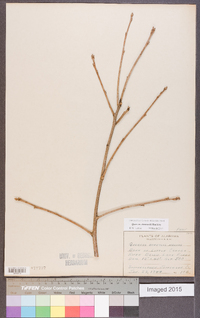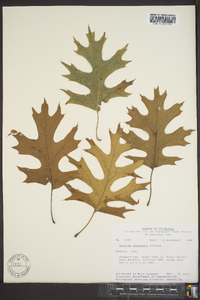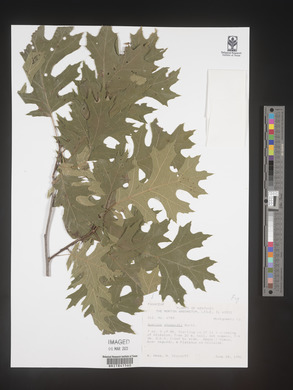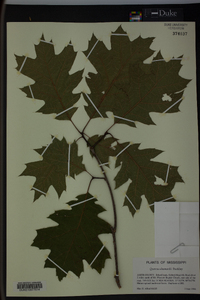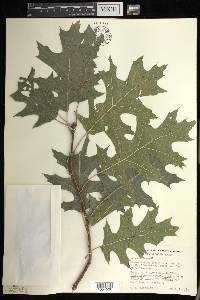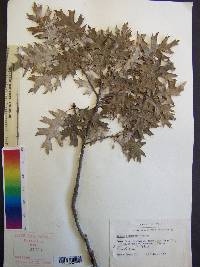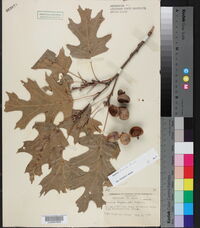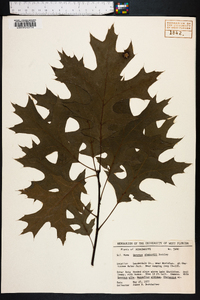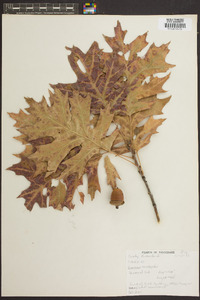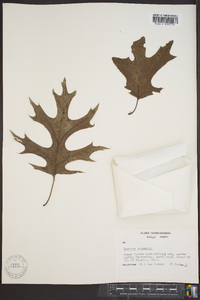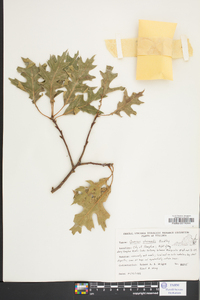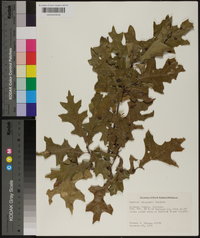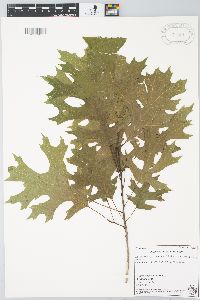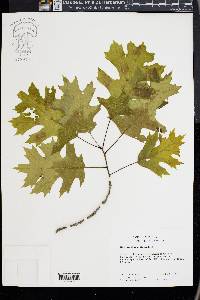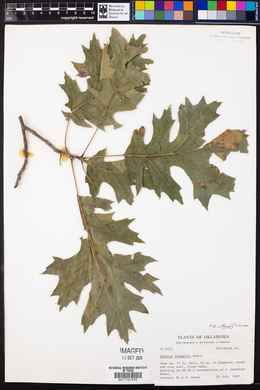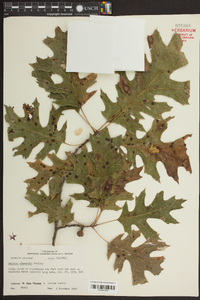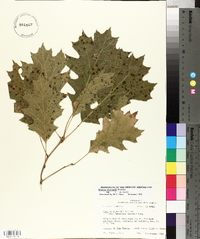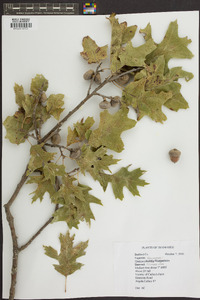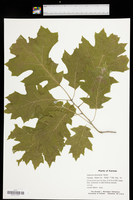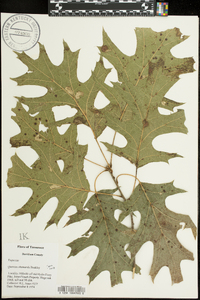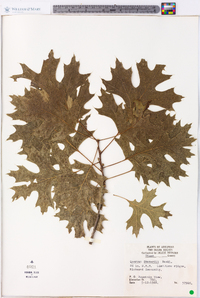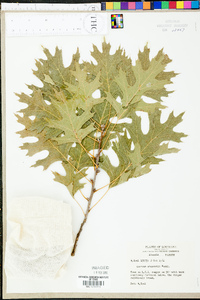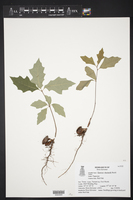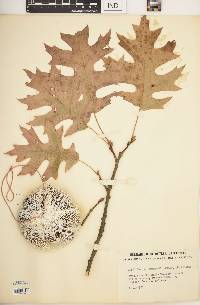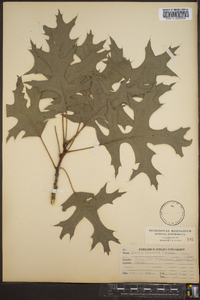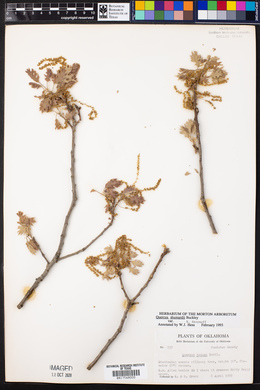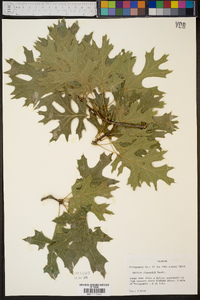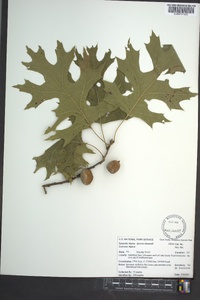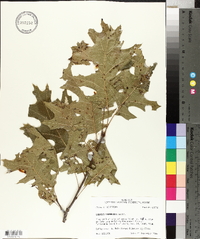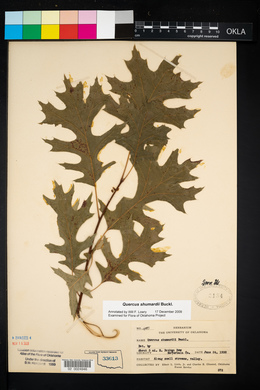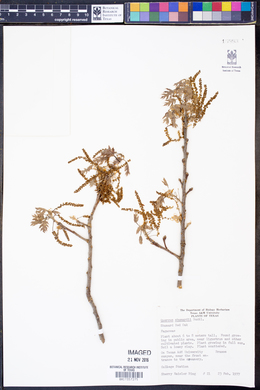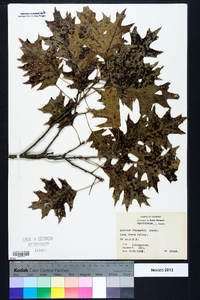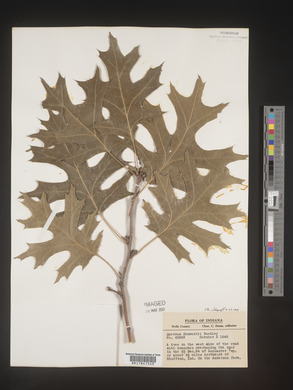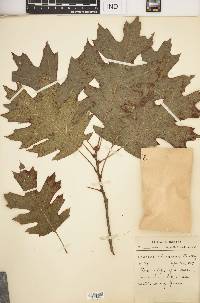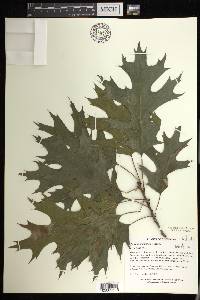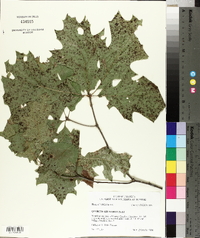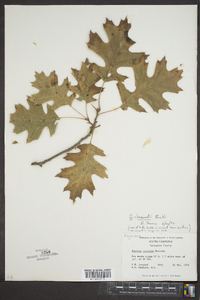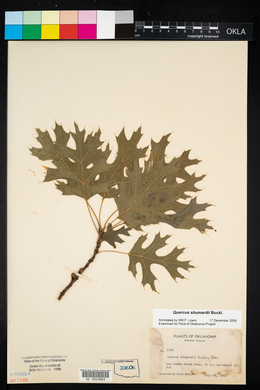Quercus shumardii
|
|
|
|
Family: Fagaceae
Shumard's Oak, more...Shumard Oak, Shumard Red Oak
|
Trees , deciduous, to 35 m. Bark gray-brown to dark brown, shallowly fissured with scaly or light-colored flat ridges, inner bark pinkish. Twigs gray to light brown, (1.5-)2-3.5(-4.5) mm diam., glabrous. Terminal buds gray to grayish brown, ovoid or broadly ellipsoid, 4-8 mm, often noticeably 5-angled in cross section, glabrous. Leaves: petiole 20-60 mm, glabrous. Leaf blade broadly elliptic to obovate, 100-200 × 60-150 mm, base obtuse to truncate, occasionally acute, margins with 5-9 lobes and 15-50 awns, lobes oblong or distally expanded, apex acute; surfaces abaxially glabrous except for prominent axillary tufts of tomentum, adaxially glossy, glabrous, secondary veins raised on both surfaces. Acorns biennial; cup saucer-shaped to cup-shaped, 7-12 mm high × 15-30 mm wide, covering 1/4-1/3 nut, outer surface glabrous or puberulent, inner surface light-brown to red-brown, glabrous or with ring of pubescence around scar, scales often with pale margins, tips tightly appressed, obtuse or acute; nut ovoid to oblong, occasionally subglobose, 14-30 × 10-20 mm, glabrous, scar diam. 6.5-12 mm. Flowering spring. Mesic slopes and bottoms, stream banks and poorly drained uplands; 0-500 m; Ont.; Ala., Ark., Fla., Ga., Ill., Ind., Kans., Ky., La., Md., Mich., Miss., Mo., Nebr., N.C., Ohio, Okla., Pa., S.C., Tenn., Tex., Va., W.Va. Trees with shallow cups covering ca. one-fourth of the nut are treated as Quercus shumardii var. shumardii ; those with more deeply rounded cups covering ca. one-third of the nut are treated as Q . shumardii var. schneckii (Britton) Sargent. Quercus shumardii var. stenocarpa Laughlin was described from several trees in Missouri and Illinois having ellipsoid acorns that were covered less than one-third their length by very small (5.5-7 mm high × 12.5-18 mm wide), shallow cups (K. Laughlin 1969). Quercus shumardii reportedly hybridizes with Q . buckleyi , Q . falcata (= Q . × joori Trelease), Q . hemisphaerica , Q . imbricaria (= Q . × egglestoni Trelease), Q . laevis , Q . laurifolia , Q . marilandica , Q . nigra , Q . palustris (= Q . × mutabilis E. J. Palmer & Steyermark), Q . phellos (= Q . × moultonensis Ashe), Q . rubra , and Q . velutina (= Q . × discreta Laughlin).
Tree 20 - 30 m tall, trunk to 1.6 m in diameter Leaves: alternate, stalked, shiny dark green above, pale beneath, 12 - 20 cm long, 8 - 12 cm wide, inversely egg-shaped with a nearly squared base, five to nine bristle-tipped lobes separated by depressions extending to three-quarters the distance to the midvein, large tufts of hairs in vein axils. Flowers: either male or female, found on the same tree (monoecious), male flowers borne in hanging catkins 14 - 18 cm long, female flowers solitary or in small clusters near leaf axils. Fruit: an acorn, maturing in two seasons, solitary or in pairs. The cup is saucer-shaped with the margin curling under, covers one-third of the nut, and has light brown, thin, tightly appressed scales. Nut 1.5 - 2.5 cm long, egg-shaped. Bark: shallowly fissured with plates or interlacing ridges. Twigs: hairy when young, becoming smooth and grayish brown. Buds: grayish to yellow, 3 - 5 mm long, egg-shaped with a pointed to rounded tip, smooth. Each terminal bud is surrounded by a cluster of lateral buds. Form: broad and rounded with large, wide-spreading branches. Similar species: Many species in the red oak group have highly variable, lobed leaves with bristle tips. Quercus rubra has shallowly lobed leaves with a somewhat dull upper surface and a very shallow saucer-shaped acorn cup that covers only the base of the nut. Quercus velutina has leaves with depressions reaching half way to the midvein, inner bark that is bright yellow to orange, and fringed acorn cups that fit loosely and cover one-third to half the nut. Quercus palustris has leaves with U-shaped depressions reaching three-quarters the distance to the midvein, dead branches remaining on the trunk, and a shallow acorn cup covering the base of the small nut. Quercus ellipsoidalis has leaves with depressions reaching three-quarters the distance to the midvein, dead branches remaining on the trunk, and an acorn cup enclosing up to half of the often elliptic nut. Quercus coccinea has leaves with C-shaped depressions reaching half the distance to the midvein, inner bark that is pink to red, and a reddish brown to orange acorn cup that covers one-third to half the nut, which has concentric rings at the tip. Flowering: April to May Habitat and ecology: Lowland areas, along the edge of water, and poorly drained upland sites. Occurence in the Chicago region: non-native Etymology: Quercus is the Latin name for oak. Shumardii is named after Benjamin Franklin Shumard (1820-1869), state geologist of Texas. Author: The Morton Arboretum Tall tree with close, deeply furrowed bark; twigs soon glabrescent; lvs smooth at maturity except for conspicuous tufts of stellate hairs in the vein-axils beneath, deeply (5)7-lobed, the sinuses commonly elliptic and extending three-fourths the distance to the midvein, the lobes oblong or usually widened distally, each with several conspicuous teeth or small lobes above; acorn-cup flatly saucer-shaped, 1-2.5 cm wide, with closely imbricate, minutely puberulent scales, covering a third or a fourth of the 1.5-3 cm nut. Chiefly in moist, lowland soil; Pa. and Va. to Ind., s. Mich., Mo., and Kans., s. to Fla. and Tex. Gleason, Henry A. & Cronquist, Arthur J. 1991. Manual of vascular plants of northeastern United States and adjacent Canada. lxxv + 910 pp. ©The New York Botanical Garden. All rights reserved. Used by permission. From Flora of Indiana (1940) by Charles C. Deam Probably frequent throughout the state where its habitat occurs. Ralph M. Kriebel in 1937 studied its distribution in relation to its habitats in different soil types and found it in sixty-four counties and I am indebted to him for this information. He, however, was unsuccessful in Benton and in several other counties in the northwestern part of the state. Since several authentic collections have been made in southern Michigan, it is believed to grow in most of our counties. In southern Indiana it is found in well-drained bottom land along streams and on the slopes of flood plain terraces. In the general area of the Wisconsin glaciations it is not found along water courses but mostly in swampy areas on the general levels, especially in soil of the Crosby and Brookston series. This oak, together with its variety [var. schneckii], the Schneck oak, and the red oak, are often found growing together. They look similar and thus are often confused but can easily be separated by studying the leaves, buds, and fruit. The leaves of red oak are dull dark green above, cut less than halfway to the midrib, 7-11-lobed, sinuses wide at the top, and the axils of the under surface have no tufts of hairs. The cup is saucer-shaped and flat on the bottom. The leaves of the Schneck and Shumard oaks are lustrous above, cut more than halfway to the midrib, 5-7-lobed, the lobes slightly converging at the top, with tufts of hairs in the axils of the veins beneath. These two oaks differ, however, in the shape of the cups of the fruit. The cup of the Shumard oak is gray and flat on the bottom while that of the Schneck oak is rounded and deeper and the scales tinged reddish brown. The terminal buds of the Shumard and Schneck oaks are generally grayish, somewhat compressed and acute at the apex while those of the red oak are generally blunt at the apex, smaller, shiny, and reddish brown. The bark of the red oak has the furrows continuous, the plates wide and gray while the bark of the Schneck and Shumard oaks is dark and the furrows broken. [Variety schneckii] differs from the type in its deep cup which is strongly convex on the bottom. The nuts are usually smaller than those of the type or those of the red oak. The variety in its characteristic form is easily separated from the type but there are intermediate forms in Indiana that can be called either the species or the variety. If this fact is kept in mind, controversies over determinations of this group may be avoided. …… Indiana Coefficient of Conservatism: C = 7 Wetland Indicator Status: FACW Deam (1932): At first there may be some difficulty in separating the Shurmard red oak, red oak, and Schneck red oak, but if the following characters are carefully weighed the separation can be made. First observe whether the leaves are lobed to beyond the middle (take care to obtain specimen growing in full sun). If not lobed to the middle, you have red oak. If they are lobed to beyond the middle you have either the Shumard red oak or Schneck red oak. If the fruit is very large, and the cup flat or only slightly convex on the bottom, you have the Shumard red oak. If the fruit is smaller and the cup slightly deeper and strongly convex on the bottom you have the Schneck red oak. The naming of specimens of this group and for that matter of all species of oak can be made when authentic specimens are at hand for comparison. |

